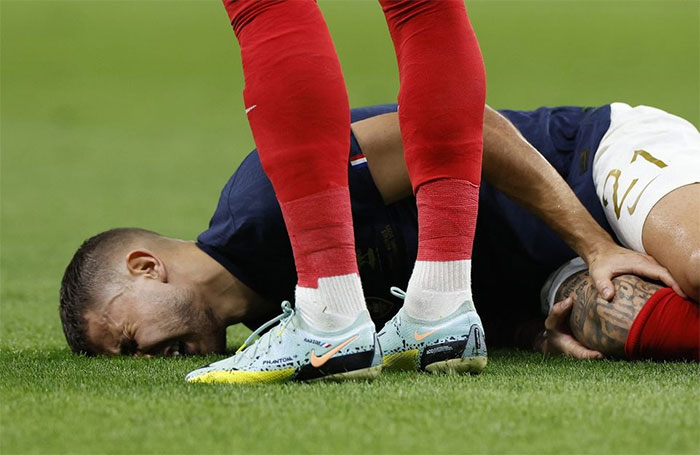Injuries to players are not new in football matches. However, the 2022 World Cup in Qatar seems to be witnessing a higher number of injuries. In fact, no team has emerged “unscathed.”
Since the start of the tournament, injuries have been one of the main topics of discussion among fans. Many theories have been proposed to explain this puzzling situation at this year’s World Cup, according to India Express.

Neymar, who was injured after a collision with Sasa Lukic during the Brazil vs. Serbia match on November 24. (Photo: Reuters).
Intense Schedule and Player Fatigue
Modern football players are required to play numerous matches, often participating in four club competitions alongside national duties. As football breaks records in advertising and viewership, many matches generate more revenue, leading to increasingly congested schedules. Even with advancements in sports science and understanding of player psychology, the packed schedules leave little time for rest and recovery.
Rest and recovery are crucial for player health. The physical demands on footballers today are exceptionally high, causing significant strain on their bodies. Aside from muscle fatigue, players face repeated heavy collisions throughout matches. The time needed for recovery is almost negligible.
For instance, in the 2021 season, Spanish midfielder Pedri (Pedro González López) played 70 official matches for FC Barcelona and the Spanish national team. This averages to more than one match per week throughout the year. Considering the season lasts just over nine months, that equates to nearly two matches per week. At just 18 years old, Pedri’s youth allows him to maintain his fitness despite the heavy burden of consistently competing in high-stakes matches.
Another example is Wayne Rooney. At 16, he was a whirlwind on the field. However, 13 years later, at 29, he had significantly declined. Rooney played in physically demanding positions, including central midfielder and left-back, alongside intricate and high-pressure plays. Now, at 37, the coach of D.C. United resembles an aging soldier, with gray hair and distant glory.
Unusual Schedule at the 2022 World Cup
Not only are players competing more, but the 2022 World Cup has set unprecedented precedents, breaking historical scheduling norms. Post-COVID-19, matches seem to be “unleashed,” and it is understandable that players are competing back-to-back across seasons.
Meanwhile, many national teams have had to exert considerable effort for the World Cup, leading to players feeling like they are on a non-stop tour. They are required to play more matches in a short timeframe leading up to the World Cup.
In addition to the high number of matches, disrupted routines also impact players’ health. The congested schedule increases physical strain, disrupting established habits, making recovery after matches longer and more challenging.
Players must constantly travel between stadiums and countries, with matches occurring irregularly. They are forced to adjust their diets and training regimens accordingly, unable to stick to fixed routines.

Lucas Hernandez clutching his leg after a collision that forced him to leave the field early on November 22. He later considered retirement before turning 30. (Photo: Reuters).
The Heat of Qatar
The reason the World Cup is held in winter is simply because the host country has weather that is too hot for competition. Playing in the summer would be a true ordeal for players.
When Qatar won the bid in 2010, the host nation promised to build air-conditioned stadiums with roofs for all fans and players. However, FIFA later realized this was merely a pipe dream.
The energy and infrastructure required for air-conditioned stadiums are economically and environmentally costly. Moreover, not the entire country is equipped with air conditioning. In the scorching 50-degree Celsius summer heat, fans fainting from heatstroke would be a disaster that FIFA would never want to witness. There was no choice but to move the World Cup to winter, with the price being disruption.
However, winter in Qatar is also not like winter in many other countries. During the day, the weather remains quite hot. At the start of the tournament, numerous training sessions had to be canceled due to excessive heat. High temperatures cause players to tire more quickly, especially those from Europe and the Americas, who are not accustomed to such extreme heat.
Player fatigue further increases the likelihood of injuries.
FIFPRO’s Concerns
The International Players’ Association (FIFPRO) expressed significant concerns even before the tournament began. Jonas Baer-Hoffmann, Secretary General of FIFPRO, stated: “I think the risk of injury and fatigue over the next four weeks is very high. This is entirely based on scientific grounds.”
Meanwhile, in an interview with The Guardian, FIFPRO advisor Darren Burgess, former director of Arsenal, suggested that this tournament would see more players absent due to soft tissue injuries that do not allow sufficient recovery time. The expert assessed the injury risk in Qatar as very high, not only for players who have played many matches but also for those lacking match fitness or overloaded like Kyle Walker or Harry Maguire.
World football is gradually becoming a dangerous game as matches increasingly feature exhausted players. More matches mean higher salaries, but in the long run, this will devastate players’ health significantly.
The number of injuries in football is on the rise, with star players missing out on matches and major tournaments. Over time, as fans cannot see their stars on the field due to injuries or fitness issues, they will gradually abandon the sport.
Some Major Injuries During the 2022 World Cup This is a list of notable players who were injured before or during the World Cup, affecting their participation in the tournament. This is not a comprehensive list, as many other players suffered both serious and minor injuries.
|


















































